Playlist
Show Playlist
Hide Playlist
Beta Thalassemia: Clinical Pathology
-
Slides Anemia Alpha Beta Thalassemia.pdf
-
Reference List Pathology.pdf
-
Download Lecture Overview
00:00 Okay. Let's take a look at laboratory. We'll take a look at major and other name for major is called Cooley's anemia. There is going to be decreased hemoglobin, hematocrit, and MCV. The RBC count will be variant and hemoglobin electrophoresis for major is going to be what please, no hemoglobin A. Majority of your hemoglobin is in form of hemoglobin F and you also have hemoglobin with, very good, A2. 00:24 What must you do with this patient? You must give this patient transfusion. 00:28 If transfusions are not given then please understand your patient as a child is going to die within a few months. However, if patients are adequately transfused, a normal childhood development can be expected. The administration of iron chelating medications to prevent secondary hemochromatosis, 50% of patients will live beyond their 55th birthday. In contrast, without early childhood transfusions, patients often have a poor development and experience something growth bony changes and heart failure that is often fatal. Finally in some cases, patients can undergo a stem cell transplant with a potential cure for the disease.
About the Lecture
The lecture Beta Thalassemia: Clinical Pathology by Carlo Raj, MD is from the course Microcytic Anemia – Red Blood Cell Pathology (RBC).
Included Quiz Questions
Which of the following is the major cause of death in beta thalassemia major?
- Cardiovascular complications
- Splenic rupture
- Stroke
- Non-hematologic malignancies
- Hematologic malignacies
Which of the following complications is LEAST likely in untreated beta thalassemia major?
- Autosplenectomy
- Bony changes
- Stunted growth
- High output cardiac failure
Customer reviews
5,0 of 5 stars
| 5 Stars |
|
1 |
| 4 Stars |
|
0 |
| 3 Stars |
|
0 |
| 2 Stars |
|
0 |
| 1 Star |
|
0 |
The videos are very clear, well explained and not too long. You can question yourself all the way along




